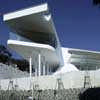Planetization, Architectural Narrative Article, International Building, World Design Projects, Nature
Planetization Architecture
Built Environment Discussion by Mphethi Morojele
17 Aug 2010
Planetization Design
Nature, Human Nature and Dragons
Planetization Architecture article by Mphethi Morojele
Three projects displayed on www.e-architect.com show intriguing relational positions with nature, both human and non-human.
In the words of Pierre Teilhard de Chardin (1881-1955) the concept of planetization “grounds us in the planetary/cosmic dimension of our existence.” It is a global and new “Earth/human bond which doesn’t just require a more evolved spatial awareness – but a higher order relational awareness” an awareness that we are not on our earth but with our earth.
“Planetization mobilizes and empowers us collectively in ways never before possible. It merges our political, ecological and spiritual energies and activism into one unified framework of thought and action. It also calls into question our most fundamental and entrenched assumptions, even how we position ourselves in Time and Space.”
Can these projects be viewed through this lens, and how would we make sense of their relational positions with nature?
The Flowing Gardens set out to create an experience of “a harmonic relation between Xi an’s wondrous past and its future of horticulture and technology, landscape and architecture.”
Primarily through the use of flowing water, these gardens are said to “transform the two conditions of artificial and natural into a sustainable system.”
My question is: can, and if so should, this wondrous past be demonstrated more forcefully in the design in its ideological sense? What is this historical landscape or, indeed the landscape of history and does the concept of planetization remove these assumptions of how we position ourselves in time and space?
The Ganesh Club initially seems to confront nature’s nature with human nature. The building emerges as a powerful and massive object that grows from the landscape in a similar way to a flower growing on a cactus “exploding in sound and light.” The building’s rhythmic additions and abstractions would seem to resemble nature’s evolutionary processes but in an unambiguously human way. Could this be viewed as an aesthetic abstraction of with the earth rather than on it?
Finally the Mountain/Opening House in Japan creates topography without topography – an ironic commentary on the disfiguration of the landscape in the name of development. The house creates mountains as concealed parts and valleys, rolling undulations that are all part of the landscape.
It delightfully recreates experiences of being in the mountains, being in the air, and of flying with dragons. Here the architecture can be seen as contributing to an expansion of our orientational referents within space, and to a lesser extent time, to include the next higher order of magnitude of space we exist within.
So what are the potentials of planetization for architecture, and how do they influence our stock-in-trade of place-making viz: genius loci, regionalism, historicism, and more importantly the socius of architecture?
This week’s guest editor is Mphethi Morojele who founded MMA Architects in Johannesburg in 1995. Since then the practice has completed several notable and award-winning projects including South Africa’s embassies in Germany (2003), Ethiopia (2009) and Freedom Park in Pretoria (2010).
Planetization Architecture article from Mphethi Morojele
Comments on this Planetization Architecture article are welcome.
Architecture Articles
Sustainable Design : article by Trevor Tucker. 15 Sep 2009
Architecture Narrative : article by Trevor Tucker. 24 Aug 2010
Sustainable Architecture Design : article by Trevor Tucker. 18 Aug 2009
Website: Architecture City Walking Tours
Nature Architecture : article by Trevor Tucker. 15 Sep 2009
Sustainable Buildings – Building Issues : article by Adrian Welch
Comments / photos for the Planetization Article page welcome








